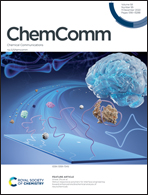Targeted design of porous materials without strong, directional interactions†
Abstract
A porous molecular crystal (TSCl) was found to crystallise from dichloromethane and water during the synthesis of tetrakis(4-sulfophenylmethane). Crystal structure prediction (CSP) rationalises the driving force behind the formation of this porous TSCl phase and the intermolecular interactions that direct its formation. Gas sorption analysis showed that TSCl is permanently porous with selective adsorption of CO2 over N2, H2 and CH4 and a maximum CO2 uptake of 74 cm3 g−1 at 195 K. Calculations revealed that TSCl assembles via a combination of weak hydrogen bonds and strong dispersion interactions. This illustrates that CSP can underpin approaches to crystal engineering that do not involve more intuitive directional interactions, such as hydrogen bonding.



 Please wait while we load your content...
Please wait while we load your content...